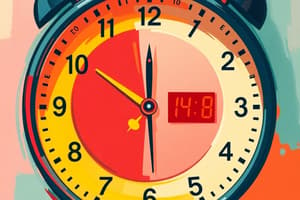Podcast
Questions and Answers
What does the short hand on an analog clock represent?
What does the short hand on an analog clock represent?
- Seconds
- Days
- Minutes (correct)
- Years
In the 24-hour format, what number represents 8 p.m.?
In the 24-hour format, what number represents 8 p.m.?
- 08:00
- 20:00 (correct)
- 12:00
- 14:00
How are time displayed on digital clocks?
How are time displayed on digital clocks?
- Using dots
- In Roman numerals
- Numerical form (correct)
- With hands
Which format uses numbers from 00 to 23 to represent hours?
Which format uses numbers from 00 to 23 to represent hours?
What does the long hand on an analog clock represent?
What does the long hand on an analog clock represent?
Which clock type has a rotating face with hands that move around the face?
Which clock type has a rotating face with hands that move around the face?
What does A.M. stand for?
What does A.M. stand for?
What is the purpose of adding an extra day in a leap year?
What is the purpose of adding an extra day in a leap year?
Where is the Prime Meridian located?
Where is the Prime Meridian located?
What is an important concept to teach children after they understand hours?
What is an important concept to teach children after they understand hours?
How can children practice telling time in both analog and digital formats?
How can children practice telling time in both analog and digital formats?
What is crucial for mastering the skill of telling time according to the conclusion?
What is crucial for mastering the skill of telling time according to the conclusion?
Flashcards are hidden until you start studying
Study Notes
Telling the Time: A Comprehensive Guide
Telling the time is an essential skill for daily life. It involves understanding how to read a clock, which can be represented in either an analog or digital format. The ability to tell time is crucial for managing appointments, scheduling events, and coordinating activities. In this article, we will explore the concept of time, the history of clocks, and various methods for teaching children to tell time effectively.
Understanding Time
Time is a fundamental concept that underpins our existence. It is a universal truth and is ingrained in every language and culture. Humanity relies on structuring daily life around dates, days of the week, minutes, hours, months, and years.
Clock Basics
Analog Clocks
Analog clocks have a rotating face with a set of hands that move around the face. The short hand represents the minutes and the long hand represents the hours. When the short hand is directly over a number, it is the minute (e.g., 10 minutes past 12). When the long hand is directly over a number, it is the hour (e.g., 3 o'clock).
Digital Clocks
Digital clocks display time in numerical form, typically as hours, minutes, and seconds. They are often found on electronic devices such as smartphones and computers.
24-Hour Format
The 24-hour format, also known as military time, uses numbers from 00 to 23 to represent hours. For example, 10 a.m. would be 10:00 in the 24-hour format.
A.M. and P.M.
A.M. stands for "ante meridiem," which means "before midday," and is represented by the abbreviation "A.M." P.M. stands for "post meridiem," which means "after midday," and is represented by the abbreviation "P.M.".
Time Zones
Time zones are regions of the Earth that have the same standard time. They are based on the time at the Prime Meridian (0° longitude), which passes through Greenwich, London.
Leap Years
A leap year occurs every four years, adding an extra day to the month of February. This is done to keep our calendar in sync with the Earth's orbital period.
Teaching Telling Time
Hour Hand
To teach children about telling time using analog clocks, start by explaining that an analog clock face is a special kind of number line. Use small post-it notes with the numbers 1 to 12 and display them horizontally in a line, equally spaced with a gap between each number.
Half-Hours
Once children understand the concept of hours, introduce the concept of half-hours. This involves understanding how the numbers between the hours work.
Minute Hand
Teach children how to tell time in units of minutes. When the minute hand points to a number, it is the number of minutes past the hour.
Converting Analog to Digital
To help children understand how to tell time in both analog and digital formats, provide them with practice exercises that involve converting clock faces to digital time and vice versa.
Hands-On Activities
Engage children in hands-on activities that involve telling time, such as making a paper clock or coloring the spaces between the numbers on an analog clock.
Time-Related Songs and Stories
Incorporate songs and stories that involve time into your lessons to help children learn in a fun and engaging way.
Digital Clocks
Introduce digital clocks to children as they progress in their understanding of time. This will help them become more familiar with various time-telling methods.
Practice and Reinforcement
Provide children with ample opportunity to practice telling time through activities, worksheets, and games.
Patience and Consistency
Teaching children to tell time can be challenging, but with patience and consistency, they will eventually master this skill.
Conclusion
Telling time is an essential skill that is fundamental to daily life. Understanding how to read an analog clock, a digital clock, and the differences between the two is crucial for managing activities and coordinating schedules. By using a combination of hands-on activities, songs, stories, and practice exercises, you can help children learn to tell time effectively.
Studying That Suits You
Use AI to generate personalized quizzes and flashcards to suit your learning preferences.




